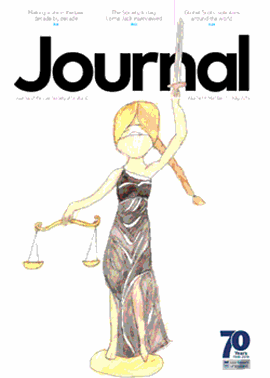Racist and sectarian bigotry in football has long been a matter of public and political concern. At the "Summit on Sectarianism" chaired by Jack McConnell earlier this year the key themes seen as central to tackling bigoted attitudes and behaviour included sport, specifically football, with the summit considering that "sport exerted a strong and important influence on people’s lives and those involved could play an important part in tackling bigotry" (Record of the Summit on Sectarianism, 14 February 2005). This article focuses on how the law deals with supporters who direct their abuse at those on the pitch, in light of the recent appeal court decision in Alan Martin v Procurator Fiscal, Dundee (17 June 2005, unreported).
The appellant in Martin had been convicted of a contravention of section 50A of the Criminal Law (Consolidation) (Scotland) Act 1995 in the following terms:
"On 17 March 2004 at Bobby Cox Stand, Dens Park Football Stadium, Sandeman Street, Dundee, you… did act in a racially aggravated manner which caused or was intended to cause alarm or distress to a person namely Scott Alexander McBurney born 01.12.1989, c/o Tayside Police in respect that you did shout racial remarks at football players of African racial origin and swear."
The conviction arose from events at a match between Dundee and Celtic. Two of the Celtic players were black, and during the game the accused, a Dundee supporter, repeatedly shouted "black bastards" and other racist abuse at them. This so offended Mr McBurney, another Dundee supporter seated nearby, that he complained to a police officer who then also heard the abuse. Section 50A, so far as relevant, provides as follows: "(1) A person is guilty of an offence under this section if he–... (b) acts in a manner which is racially aggravated and which causes, or is intended to cause, a person alarm or distress. " Here there was no suggestion that the players themselves heard anything, or that the accused had directed any insults towards Mr McBurney. Who, then, is "a person" for the purposes of section 50A(1)(b) – does it include someone who was not the target of the abuse but merely a bystander? The appeal court in Martin held that it does not:
In short, for a prosecution under section 50A to succeed the person at whom the conduct is directed and the person alarmed or distressed by it must be one and the same. The charge was accordingly irrelevant. This answers a question left unresolved by Anderson v Griffiths 2005 SCCR 41, another football case. In contrast to Martin, the "complainers" were the two black players (named in the charge) at whom the abuse was directed, not the supporters who overheard it. The appellant had been convicted of contravening section 50A by shouting "black bastard" and "asylum seeker" at the players during a game between St Johnstone and Livingston. He did not shout loudly enough to be heard by the players themselves, but other supporters gave evidence that they had been upset and disgusted by his behaviour (though as the complaint libelled only alarm and distress to the players, the relevance of that evidence is perhaps questionable). Given the lack of evidence that the abuse caused actual alarm or distress to the players, the decisive consideration for the appeal court in quashing the conviction was that the sheriff had not found in fact that the appellant’s actions were intended to cause them alarm or distress. In the circumstances the Crown conceded that the conviction under section 50A could not stand. The court therefore did not have to consider whether for conviction of this offence the only alarm and distress that could be taken into account was that of the person at whom the abuse was directed (or indeed, whether the term "asylum seeker" was racially abusive). The court in Martin recognised that its construction of section 50A may inhibit the use of this provision in the prosecution of conduct other than specific abuse aimed at a specific person. It did however note that section 50A(1)(b) contains the phrase "intended to cause", observing:
It appears then that a successful prosecution could follow where the complainers are the (unwitting) targets of the abuse – as in Anderson – provided there is sufficient evidence that the accused either caused them alarm or distress or attempted to do so. There remains the option of using the common law offence of breach of the peace to prosecute such behaviour. That the accused directed his abuse at A but only B and C were alarmed by it would not preclude a relevant complaint of breach of the peace, provided the behaviour is severe enough to meet the test laid down in Jones v Carnegie 2004 JC 136 – that is, conduct which presents as genuinely alarming and disturbing, in its context, to any reasonable person. Accordingly in both Anderson and Martin the appeal court substituted for conviction under section 50A conviction for breach of the peace racially aggravated within the meaning of section 96 of the Crime and Disorder Act 1998. Section 96 provides: "(2) An offence is racially aggravated for the purposes of this section if–
Clearly in Martin and Anderson the offence was motivated by malice and ill-will towards members of a racial group based on their membership of that group (though in neither case does the appeal court elaborate on this point). Furthermore, section 96(4) goes on to say that it is immaterial whether or not the offender's malice and ill-will is also based to any extent on any other factor. It would therefore not assist an accused person in this situation to argue that, for instance, his behaviour stemmed from the natural enmity between teams at a sporting event. Evidence from only one source is required in order to establish the aggravation – although of course the fact that a breach of the peace had been committed at all would require to be proved by corroborated evidence. If the aggravation is established it must be taken into account in sentencing. Finally, section 74 of the Criminal Justice (Scotland) Act 2003 provides a new statutory aggravation of religious prejudice, where the offence is motivated wholly or partly by malice and ill-will towards members of a religious group, or of a social or cultural group with a perceived religious affiliation, based on their membership of that group. In the type of situation described in this article section 74 is perhaps of particular interest, given the long association between football and sectarian rivalry in Scotland and the Executive’s widely publicised desire to eradicate such behaviour.
In this issue
- Prosecuting bigotry offences
- A hotter than average July
- Advice for all, but what about justice?
- Calling time
- The anti-avoidance drive
- The best option?
- Radical design
- Miscarriages of justice
- Information technology
- IPS... keeping a watchful eye
- When less means better
- Reality check - not Big Brother
- A clear duty
- Missing a generation
- Does age matter?
- Fair picture?
- Book debts: the final word?
- Website reviews
- Book reviews
- Challenging the sacred cows of conveyancing







